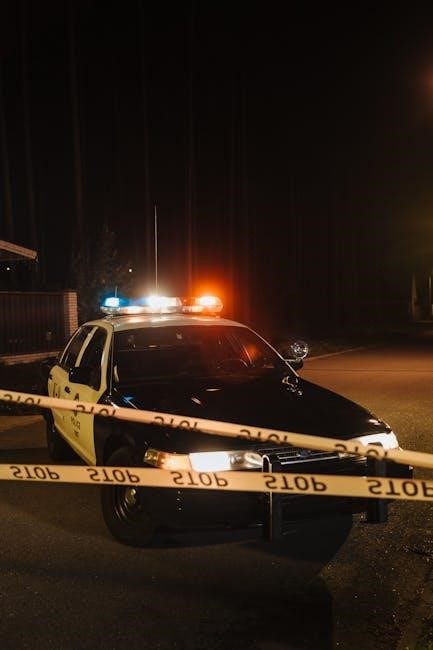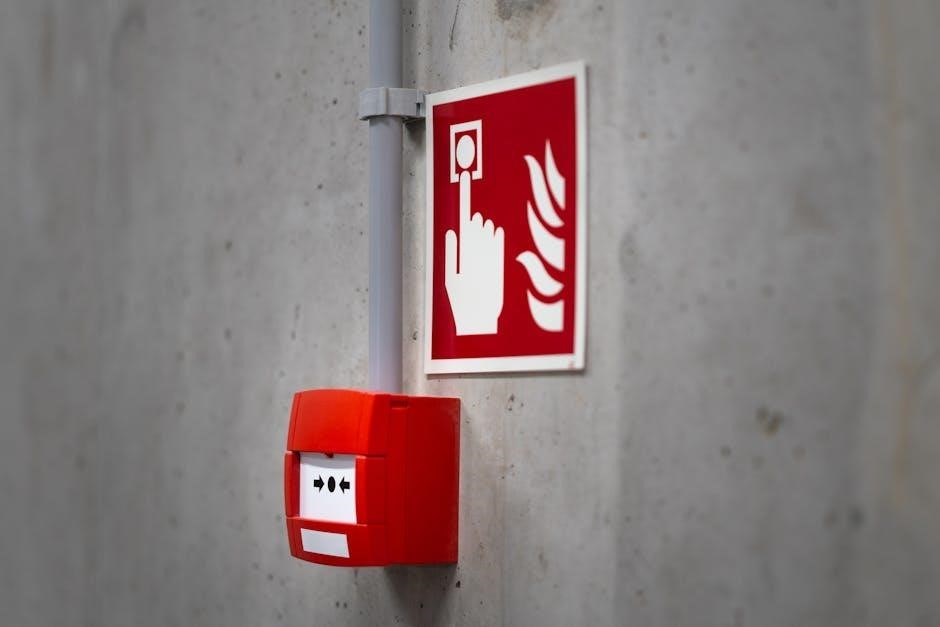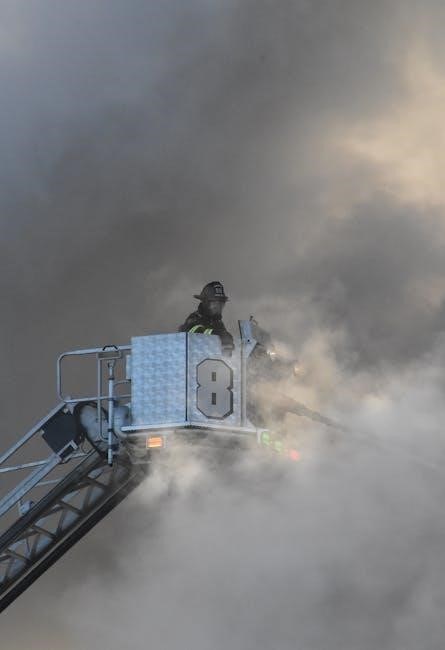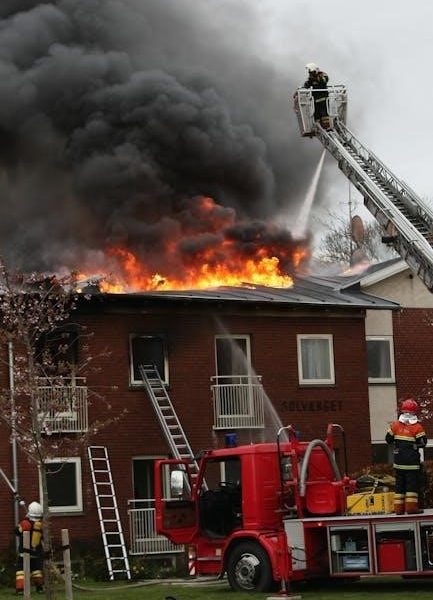Welcome to the First Alert Smoke Alarm Carbon Monoxide Manual, your comprehensive guide to understanding and maintaining your smoke and CO detector for enhanced home safety․
Overview of the Manual’s Importance
The First Alert Smoke Alarm Carbon Monoxide Manual is an essential resource for ensuring your home is equipped with a reliable safety system․ This guide provides detailed instructions for installation, maintenance, and troubleshooting, helping users maximize the performance of their smoke and CO detectors; Understanding the manual’s content is crucial for identifying alarm sounds, resolving false alerts, and performing regular tests to ensure functionality․ It also covers critical safety measures, such as what to do when the CO alarm activates and how to prevent false alarms․ By following the manual, users can safeguard their homes and families from potential dangers․ Regular upkeep, like battery replacement and sensor cleaning, is emphasized to maintain optimal detection capabilities․ This manual serves as a comprehensive toolkit for anyone seeking to enhance home safety and respond effectively to emergencies․

Key Features of the First Alert Smoke and CO Alarm
The First Alert Smoke and CO Alarm is designed with advanced features to ensure maximum home safety․ It combines both smoke and carbon monoxide detection in one unit, providing dual protection․ The alarm features a loud, clear siren to alert occupants in emergency situations․ Indicator lights, such as a flashing red light, provide visual cues for alarm status or silenced mode․ The unit includes a test/silence button for easy self-testing and temporary silencing of false alarms․ Hardwired models offer continuous power with a battery backup for reliability during outages․ The alarm also includes a self-test function, which ensures sensors are functioning correctly․ These features make it a reliable and user-friendly choice for protecting homes from fire and carbon monoxide threats․ Regular updates and maintenance are supported through simple processes outlined in the manual;

Understanding the First Alert Smoke and CO Alarm
The First Alert Smoke and CO Alarm offers dual protection by detecting both smoke and carbon monoxide, ensuring comprehensive home safety with reliable alerts and clear indicators․
Types of Alarms and Their Functions
The First Alert Smoke and CO Alarm combines smoke detection and carbon monoxide monitoring in one unit, offering dual protection for your home․ Smoke alarms detect particles in the air caused by fire, triggering loud beeps and flashing lights․ Carbon monoxide detectors, on the other hand, identify dangerous levels of CO gas, which is odorless and invisible, by emitting a distinct alarm pattern․ Both functions work together to provide early warnings for potential threats․ The alarm also features a silence button to temporarily mute false alarms, such as those caused by cooking smoke․ Understanding the different types of alarms and their functions ensures you can respond appropriately during emergencies․ Regular testing is essential to verify that both smoke and CO detection are functioning correctly․ This dual-protection system is designed to keep your family safe from both fire and invisible gas hazards․
The Role of Sensors in Detection
The First Alert Smoke and CO Alarm relies on advanced sensors to detect smoke particles and carbon monoxide gas accurately․ Smoke sensors use optical or ionization technology to identify even small amounts of smoke in the air, triggering the alarm quickly․ Carbon monoxide sensors, often electrochemical or metal-oxide based, monitor CO levels over time and sound an alert if dangerous concentrations are detected․ These sensors are designed to provide early warnings, allowing you to take action before a threat escalates․ Regular maintenance, such as cleaning and testing, ensures sensors remain sensitive and reliable․ The combination of smoke and CO sensors in one device offers comprehensive protection, making it a crucial component of home safety systems․ Proper sensor function is vital for the alarm to operate effectively and safeguard your family from potential hazards․
Indicator Lights and Their Meanings
The First Alert Smoke and CO Alarm features indicator lights that provide crucial information about its status and operation․ A red light flashes every 10 seconds when the alarm is in silence mode, reminding you it has been temporarily muted․ After approximately 10 minutes, the alarm will automatically reset․ During normal operation, a green light flashes to indicate the device is functioning properly and powered correctly․ If a yellow light appears, it signals a low battery or a potential issue with the power connection․ Understanding these lights is essential for maintaining your alarm’s effectiveness and ensuring your home remains protected from smoke and carbon monoxide threats․

Installation and Setup
Proper installation ensures optimal performance․ After mounting, press and hold the test button to confirm the alarm is functioning․ A green light indicates successful setup and power․ Replace batteries as needed and test again to ensure reliability․ Always follow manual instructions for wiring or battery installation to avoid malfunctions․ Once installed, verify the alarm by triggering a test to ensure it sounds and lights activate correctly․ This step ensures your home is protected from smoke and carbon monoxide threats effectively․ Regular testing post-installation is crucial for maintaining safety standards․ Ensure all features are operational before finalizing the setup․
Step-by-Step Installation Guide
Choose a location on the ceiling or wall, at least 10 feet from cooking appliances to minimize false alarms․ Ensure the area is clean and dry․ For hardwired models, turn off power at the circuit breaker before starting․ Mount the bracket using screws or adhesive strips provided․ Gently snap the alarm into place until it clicks securely․ For battery-powered units, insert fresh batteries as indicated in the manual․ For hardwired models, connect the wires to the terminal screws, ensuring proper polarity․ Replace any connector plugs if necessary․ Press and hold the Test button until the alarm sounds and the light flashes, confirming it’s operational․ Finally, interconnect all alarms in the system to ensure they activate simultaneously․ Regular testing post-installation ensures reliability and safety․
Choosing the Right Location for the Alarm
When selecting the optimal location for your First Alert Smoke and Carbon Monoxide Alarm, consider the following guidelines to ensure effective coverage and minimize false alarms:

- Install alarms on every level of your home, including inside each sleeping area, to ensure comprehensive protection․
- Place alarms at least 10 feet away from cooking appliances to reduce the likelihood of false alarms caused by cooking fumes․
- Mount alarms on the ceiling or high on walls, typically between 4 to 12 inches from the ceiling, to maximize smoke detection efficiency․
- Avoid installing alarms near windows, doors, or areas with drafts, as airflow can interfere with sensor accuracy․
- For carbon monoxide detection, consider placing alarms near the floor, as CO is denser than air, though combination units can be mounted higher․
- Ensure alarms are interconnected so that if one detects a threat, all units alert simultaneously, enhancing safety throughout the home․
- Check local building codes and regulations for specific requirements regarding the number and placement of smoke and CO alarms․
- Position alarms in accessible locations to facilitate easy maintenance, such as battery replacement and cleaning․
By strategically placing your alarms according to these guidelines, you can create a safer living environment with reliable detection and minimal false alarms․
Wiring and Connectivity Options
First Alert Smoke and Carbon Monoxide Alarms offer flexible wiring and connectivity options to suit various home setups․ Hardwiring is a reliable choice, connecting the alarm to your home’s electrical system (120V)․ This eliminates battery replacements and provides continuous power․ Battery-powered models are ideal for homes without easy access to wiring, offering a 10-year sealed battery for maintenance-free operation․ For interconnectivity, First Alert alarms can link with up to 18 compatible devices, ensuring all units sound an alert when one detects a threat․ Some models also support smart home integration via Wi-Fi or Bluetooth, enabling remote notifications and control through a smartphone app․ Always follow the manual’s wiring instructions and consider consulting a licensed electrician for hardwiring․ Proper connectivity ensures seamless performance and enhanced safety for your home and family․

Maintenance and Testing
Regularly clean the alarm with a vacuum or soft brush to remove dust․ Test the alarm monthly and ensure proper ventilation around the unit․ Schedule annual professional inspections for optimal functionality․
How to Replace Batteries
To replace the batteries in your First Alert Smoke Alarm Carbon Monoxide Manual, start by ensuring the alarm is powered off if it’s a hardwired model․ Locate the battery compartment, which may require removing a cover—some models have a hinged cover, while others need a screwdriver․ Once accessible, disconnect the old batteries, noting the positive and negative terminals for correct installation․ Dispose of the old batteries safely․ Insert the new batteries, aligning the terminals correctly as per the manual; Secure the compartment tightly․ Finally, test the alarm using the test button to ensure it functions properly․ Remember to replace batteries annually or when the low-battery chirp sounds to maintain reliability․ Cleaning the alarm occasionally can also prevent dust buildup and ensure optimal performance․ Regular maintenance helps keep your home safe and the alarm functioning effectively; Always refer to the manual for specific instructions tailored to your model․ By following these steps, you can ensure your First Alert Smoke Alarm remains operational and ready for emergencies․ Proper battery replacement is essential for the safety and functionality of your smoke and carbon monoxide alarm․ Stay proactive with annual replacements and testing to guarantee your home’s protection․
Regular Testing Procedures
Regular testing is crucial to ensure your First Alert Smoke Alarm Carbon Monoxide Manual operates effectively․ Begin by pressing the test button located on the front of the alarm․ This will trigger a loud siren, confirming the unit is functioning properly․ Additionally, check for the presence of any chirping sounds, which may indicate low battery levels or other issues․ For carbon monoxide detection, use a can of smoke or a CO test spray to simulate conditions and verify the alarm responds appropriately․ Always follow the manufacturer’s guidelines for testing to ensure accuracy․ It is recommended to test the alarm monthly to maintain reliability and safety․ Regular testing helps identify potential issues before they become critical, ensuring your home remains protected from fire and carbon monoxide threats․ Stay vigilant with consistent testing to guarantee the alarm’s effectiveness in emergencies․ This routine maintenance is essential for your safety and peace of mind․
Cleaning and Upkeep Tips
Regular cleaning and upkeep are essential to ensure your First Alert Smoke Alarm Carbon Monoxide detector functions accurately․ Start by vacuuming the exterior gently to remove dust and debris that may accumulate․ Use a soft brush to clean the grille, ensuring all openings are clear․ Avoid using harsh chemicals or abrasive cleaners, as they can damage the sensor․ Instead, dampen a cloth with water and wipe down the exterior if necessary․ Check for any insect buildup inside the alarm and clean it out carefully to prevent interference․ For optimal performance, clean the alarm every 30 days․ Additionally, never paint the detector, as this can block the sensors and reduce effectiveness․ Always follow the manufacturer’s guidelines for maintenance to keep your alarm in top condition and ensure your safety․ Regular upkeep helps prevent false alarms and ensures reliable detection of smoke and carbon monoxide․ By maintaining your alarm, you protect your home and family from potential threats․

Troubleshooting Common Issues
Troubleshooting your First Alert Smoke Alarm Carbon Monoxide detector helps resolve common problems like false alarms, error lights, or chirping noises․ Refer to specific sections for detailed solutions․
Resolving Chirping or Beeping Noises
Chirping or beeping noises from your First Alert Smoke Alarm Carbon Monoxide detector typically indicate low battery levels or other system issues․ If your alarm is battery-powered, replace the batteries with fresh ones of the correct type (usually AA or 9V)․ For hardwired models, check the backup battery and ensure proper wiring connections․ If the issue persists, press the test/silence button to reset the alarm․ Clean the sensor with a vacuum or soft brush to remove dust or debris that may cause false signals․ If none of these steps resolve the problem, the sensor or alarm may be faulty and require replacement․ Always refer to your manual for specific instructions tailored to your model․

Fixing False Alarms and Error Lights
Resetting the Alarm After Activation
Resetting your First Alert Smoke Alarm Carbon Monoxide detector after activation is essential to restore normal operation․ Once the alarm sounds, press and hold the test/silence button until the alarm stops․ This temporarily mutes the alert․ Ensure the area is clear of smoke or CO by opening windows or ventilating the space․ The alarm will automatically reset once the sensor no longer detects danger․ If the alarm does not reset, check for ongoing threats or obstructions․ If issues persist, replace the batteries or consult the manual for further troubleshooting․ Always verify the alarm is functioning correctly after resetting to ensure your safety․

Frequently Asked Questions
Are First Alert alarms reliable? Yes, they are known for accuracy and durability․ How many detectors do I need? Install one per level and sleeping area․ Can I hardwire them? Yes, for continuous power․ Always follow manual instructions for optimal performance and safety․
Are First Alert Alarms Prone to False Alarms?
Are First Alert alarms prone to false alarms? While rare, false alarms can occur due to dust, steam, or cooking fumes interfering with sensors․ To minimize this, ensure proper installation, clean the alarm regularly, and avoid placing it near kitchens or bathrooms․ First Alert alarms are equipped with advanced sensors designed to reduce false alarms while maintaining sensitivity to real threats․ Regular maintenance, such as dusting the grille and updating batteries, further enhances reliability․ If a false alarm occurs, pressing the hush button or resetting the alarm typically resolves the issue․ First Alert’s commitment to quality ensures their alarms remain a trusted choice for home safety, balancing accuracy with minimal false detections․
How to Diagnose a Malfunctioning Detector
Diagnosing a malfunctioning First Alert smoke and CO detector involves checking for common issues like power outages, dead batteries, or sensor blockage․ Start by verifying the alarm is powered on and batteries are fresh․ If hardwired, ensure the circuit breaker hasn’t tripped․ Next, inspect the detector for dust or debris, which can block sensors․ Test the alarm using the test button or a small amount of smoke/CO to ensure it responds․ Check for error lights or unusual sounds, as these often indicate specific problems․ If the issue persists, consult the manual or contact customer support․ Regular maintenance and testing can help identify and resolve issues early, ensuring your alarm functions correctly when needed․
What to Do When the CO Alarm Goes Off
If the CO alarm sounds, take immediate action to ensure safety․ Evacuate the premises and call emergency services right away․ Do not delay or investigate the source yourself․ Open windows and doors to ventilate the area if it is safe to do so․ Avoid using fuel-burning appliances or vehicles indoors until the issue is resolved․ Check if anyone is experiencing symptoms of CO poisoning, such as headaches, dizziness, or nausea, and seek medical attention if necessary․ Once the area is deemed safe, reset the alarm and ensure all potential CO sources are inspected by a professional․ Always follow safety guidelines and never ignore the alarm, as CO is odorless, colorless, and deadly․

Safety Tips and Best Practices
Ensure optimal protection by installing alarms on every level of your home and in sleeping areas․ Test alarms monthly and replace batteries annually․ Keep alarms clean, free from dust, and away from cooking areas to minimize false alarms․ Never disable an alarm; instead, use the hush feature if needed․ Replace alarms every 10 years or as per the manufacturer’s instructions․ Store backup power sources like batteries securely․ Always follow local fire and safety codes for installation and maintenance․ Regularly review escape plans with household members and practice drills to ensure readiness in emergencies․ Stay informed about potential hazards and updates on your alarm system․
General Safety Guidelines for Smoke and CO Alarms
Install smoke and CO alarms on every level of your home, including inside and outside sleeping areas․ Test alarms monthly and replace batteries annually or as indicated․ Ensure alarms are clean and free from dust․ Never disable an alarm; use the hush feature if needed․ Replace alarms every 10 years or as per the manufacturer’s instructions․ Store backup power sources securely․ Follow local fire and safety codes for installation and maintenance․ Regularly review escape plans with household members and practice drills․ Stay informed about potential hazards and system updates․ Keep alarms away from cooking areas to reduce false alarms․ Always have a backup power source, like batteries, for hardwired systems․ Regular maintenance ensures reliability and effectiveness in emergencies․
Preventing CO Poisoning in the Home
Carbon monoxide (CO) poisoning is a silent killer, as it is odorless, colorless, and tasteless․ To prevent CO poisoning, ensure all fuel-burning appliances, such as furnaces, water heaters, and generators, are installed and maintained properly․ Never use generators or grills indoors or in enclosed spaces, as they can produce deadly CO levels quickly․ Have your heating system and chimney inspected annually by a qualified professional․ Keep flues and vents clear of blockages․ Never idle a car in an attached garage, even with the door open․ Use CO alarms as an additional layer of protection․ Replace alarms every 10 years․ If your CO alarm sounds, evacuate immediately and call emergency services․ Be aware of symptoms like headaches, dizziness, and nausea, which can indicate CO exposure․ Act quickly to prevent serious harm or fatalities․


